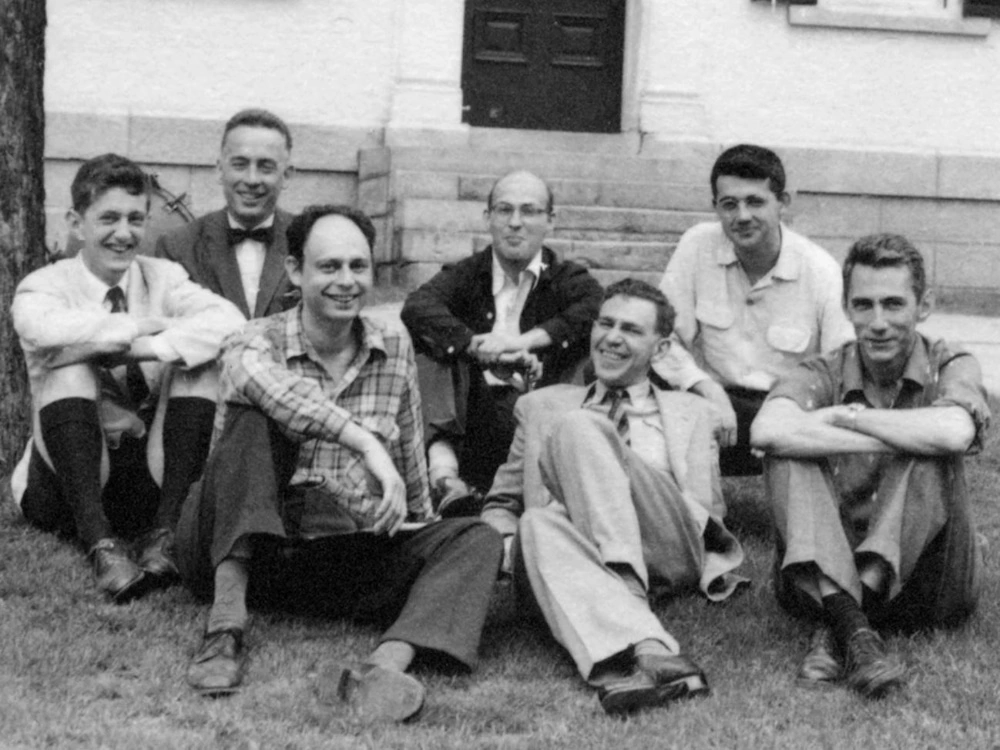 Dartmouth Conference
Dartmouth Conference
Artificial Intelligence as a term originated at the 1956 conference
Related: History of AI | AI Research | User Groups
The Dartmouth Conference is considered the birthplace of artificial intelligence as a formal field of study.
Organized by John McCarthy, with help from Marvin
Minsky, Nathaniel Rochester, and Claude Shannon, the conference brought together
leading researchers in mathematics, neuroscience, and computing to explore the
idea that machines could simulate human intelligence. The term "artificial
intelligence" was coined at this event.
Though the 1956 conference did
not produce research papers or working AI systems, it set the
research agenda for AI for the next
several decades. Attendees later went on to develop machine learning, expert
systems, neural networks, and more, laying the foundation for modern AI advancements.

The original AI community, the men who launched AI at Dartmouth College in 1956.
From left to right: Oliver Selfridge, Nathaniel Rochester, Ray Solomonoff,
Marvin Minsky, Trenchard More, John McCarthy, Claude Shannon.
 The Participants
The Participants
"We propose that a 2-month, 10-man study of artificial intelligence be carried out...The study is to proceed on the basis of the conjecture that every aspect of learning or any other feature of intelligence can in principle be so precisely described that a machine can be made to simulate it."
- John McCarthy (Organizer, MIT and Dartmouth): Coined the term "Artificial Intelligence". Later developed LISP, the first AI programming language. Pioneered AI concepts like time-sharing and heuristic programming. Won the Turing Award in 1971.
- Marvin Minsky (MIT and Harvard): Co-founded the MIT AI Lab. Advanced work on neural networks and machine learning. Wrote The Society of Mind, a key work on AI and human cognition. Won the Turing Award in 1969.
- Nathaniel Rochester (IBM): Designed the first IBM computer, the 701. Explored machine learning and AI for early computing systems.
- Claude Shannon (Bell Labs, "Father of Information Theory"): Developed the mathematical foundations of digital communication. Explored machine learning, chess-playing computers, and cryptography. Won the Nobel Prize in 1939.
- Allen Newell and Herbert Simon (Carnegie Institute of Technology, later Carnegie Mellon): Created the Logic Theorist, an early AI program that proved mathematical theorems. Their later work led to the development of expert systems and cognitive science.
- Ray Solomonoff (Mathematician and AI Theorist): Developed algorithmic probability theory, a foundation for modern machine learning. Early ideas about predictive AI and pattern recognition.
- Oliver Selfridge (MIT, "Father of Machine Perception"): Worked on pattern recognition and early neural networks. Helped shape the field of computer vision.
- Trenchard More (Mathematician and Theorist): Contributed to symbolic logic and reasoning in AI.
"An attempt will be made to find how to make machines use language, form abstractions and concepts, solve kinds of problems now reserved for humans, and improve themselves."
 The Story
The Story
The Dartmouth Conference, officially the Dartmouth Summer Research Project on Artificial Intelligence, took place at Dartmouth College in Hanover, New Hampshire, from June to August 1956. It's widely regarded as the birthplace of AI as a field, and John McCarthy's coining of the term "Artificial Intelligence" was a defining moment.
The spark behind the research project was John McCarthy's vision. McCarthy was a 28-year-old mathematician and computer scientist. After his PhD at Princeton (1949-1951) and stints at Stanford and Bell Labs, he joined Dartmouth as an assistant professor in 1955. He was fascinated by machines that could mimic human reasoning; not just calculate, but think. McCarthy wanted to explore whether machines could simulate intelligence by solving problems, learning, and reasoning like humans. He didn't just want a summer chat; he aimed to kickstart a new discipline.
In 1955, McCarthy teamed up with Harvard grad student Marvin Minsky, Nathaniel Rochester from IBM, and Claude Shannon from Bell Labs to pitch the conference. They wrote a document titled "A Proposal for the Dartmouth Summer Research Project on Artificial Intelligence" and submitted it to the Rockefeller Foundation for funding. They proposed a "2-month, 10-man study of artificial intelligence be carried out to proceed on the basis of the conjecture that every aspect of learning or any other feature of intelligence can in principle be so precisely described that a machine can be made to simulate it."
McCarthy coined the term 'Artificial Intelligence' for this proposal. He chose it over alternatives like 'thinking machines' or 'automata studies' because it was broad, ambitious, and avoided sci-fi vibes. He later said it was "snappier" and he wanted to "nail it to the mast", to cement the claim that intelligence wasn't uniquely human.
The Rockefeller Foundation awarded $7,500 (about $80K today) which was not a fortune, but enough for a summer workshop. Dartmouth provided the venue (the math department's rooms). During the eight week stint, there were about ten core participants, a tight crew of visionaries (listed above). McCarthy, Minsky, Shannon, and Rochester were the key participants, while others came and went as their schedules dictated.
The format of the workshop was informal, like brainstorming over coffee, instead of conducting rigid lectures. They met in Dartmouth's math building, sharing their research interests, and tossing around ideas. The goal of the workshop was to test the hypothesis that intelligence could be broken down into processes machines could replicate. Topics included:
- Problem-solving (e.g., Newell and Simon's Logic Theorist, which proved math theorems)
- Language processing (early natural language processing dreams)
- Learning systems (whether machines could improve over time)
One of the key moments of the conference occurred when Newell and Simon demoed Logic Theorist, a program that proved theorems from Whitehead and Russell's Principia Mathematica. It wowed attendees because it was proof that machines could think symbolically. Minsky and Rochester explored neural networks, although symbolic AI dominated the conference. McCarthy pushed for general-purpose intelligent systems, not just narrow tools.
 The Significance
The Significance
Prior to the conference, computing was about calculations (e.g., Turing's work) or code-breaking (again, Turing's work). Dartmouth shifted the focus to intelligence simulation, launching AI as a discipline. The proposal predicted huge advances in the next decade, which turned out to be overly optimistic, although it did set the tone for the future. After the conference attendees went their separate ways and produced amazing results, shaping decades of research.
- McCarthy - invented LISP, the first AI programming language
- Minsky - co-founded the MIT AI Lab
- Newell and Simon - created the Logic Theorist
 The Aftermath
The Aftermath
There were no minutes of the meetings, no computers were used, no reserch papers were published. Aside from producing the term 'artificial intelligence', what did the 1956 conference accomplish? The conference that assembled the leading researchers and practitioners of the time fundamentally created a vision of thinking machines, a theory that would eventually become reality. It was less a single eureka moment and more a summer of bold ideas that launched a field of inquiry, a field that ultimately culminated in our Age of AI.
 Links
Links
home.dartmouth.edu/about/artificial-intelligence-ai-coined-dartmouth
historyofdatascience.com/dartmouth-summer-research-project-the-birth-of-artificial-intelligence
ojs.aaai.org/aimagazine/index.php/aimagazine/article/view
en.wikipedia.org/wiki/Dartmouth_workshop
klondike.ai/en/ai-history-the-dartmouth-conference
http://jmc.stanford.edu/articles/dartmouth/dartmouth.pdf
computerhistory.org/events/1956-dartmouth-workshop-its-immediate
www-formal.stanford.edu/jmc/history/dartmouth/dartmouth